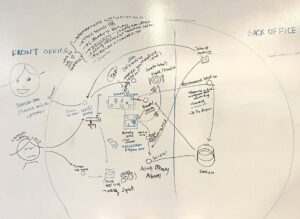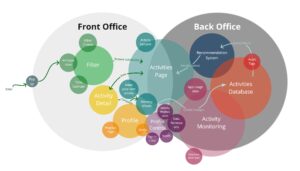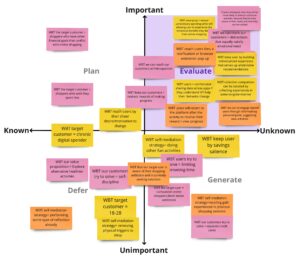We are excitedly progressing towards a solution to help Spencer the Spender achieve their goal of reducing impulsive online spending. Ahead of our next round of testing, we drew upon our intervention study findings to map out our system and set of assumptions.
System Path
After seeing that participants who were shopping for a functional need were unaffected by both introspection prompts and substitution activities, we decided to focus on the undirected online shopper. We sketched out the user’s interaction with our solution’s front office, as well as the internal handshakes between the front and back offices to power the system’s core functionality: recommending a “platter” of substitute activities.

Figure 1 – System Path showing preliminary architecture and user touch points
Bubble Architecture Map
Next, we built a Bubble Map that explores the design architecture outlined in the System Path, most notably:
- the Filter that prompts users to introspect on why they are browsing
- the Activity Sampler within the Activities Page which works with the Recommendation System, Database, and Activity Monitoring functionalities to serve up relevant activity substitutes
- and lastly the Profile for user preferences. The green and baby blue arrows represent how a user and data flows through the system’s components (circles) respectively
- The circle sizes represent the content volume of each component.

Figure 2 – Bubble Map further fleshes out System Path
Assumption Map
To finish off our visual synthesis, we each individually brainstormed critical assumptions underlying our system design. We concentrated on pulling out assumptions regarding whether users will want our solution. Assumptions generally fell under the following categories:
- target user
- value proposition
- existing solution attempts
- reaching users
- keeping users

Figure 3 – Assumption Map critical to our solution design; WBT = We believe that …
Assumption Test
We ended up picking the assumption on the most upper-right position as the highest priority one to test! We formulated the assumption as the following hypothesis:
If users introspect on the emotional needs underlying their urge to browse, then they’ll be more likely to attempt a substitute activity, because they’re more aware of their needs and how they can be fulfilled alternatively.
To this end, we design a study with two conditions:
- Control condition: No introspection prompts; we show them a full list of substitute activities.
- Experimental condition: We ask them to self-reflect their emotional needs via introspection questions. Based on their responses, we recommend a curated list of alternative activities, filtered down from the original list shown to the control group.
If our hypothesis is true, we expect more users under the experimental condition to attempt the substitute activities than the control condition.
Study Proposal
We plan to ask each participant to give us two data points (one from the control condition, and one from the experimental condition). To reduce bias, we will randomize the order of conditions that each participant receives.
- When participants feel an urge to browse online, they will notify our “bot” by directly messaging it.
- The “bot” will ask introspection questions and respond according to a simple logic tree of prompts.
- Based on the participant’s answers, we will “Wizard of Oz” a curated recommended list of substitute activities.
- Finally, the “bot” will ask the participant to report what happened after a designated amount of time.



